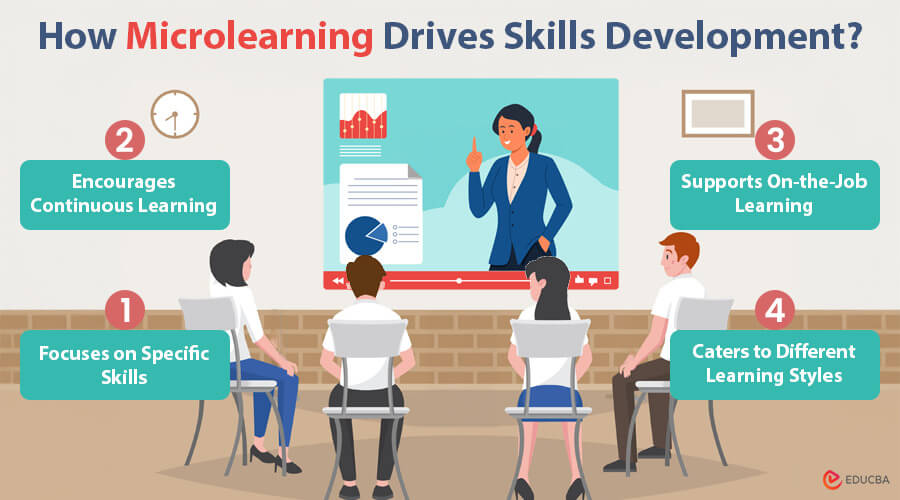
What is Microlearning?
Microlearning is a training strategy that delivers small, focused bursts of information, usually in short videos, quizzes, infographics, or articles. Unlike traditional courses that can last hours or days, microlearning content typically takes just a few minutes to consume. It is easy to absorb and perfect for busy professionals who need to learn while on the move.
Why Microlearning Works?
Here are some reasons why microlearning works so well:
- Better Retention: Studies show people remember information better when delivered in short, relevant bursts. Microlearning takes advantage of this by providing concise, focused content.
- Flexibility and Accessibility: It is available anytime and anywhere, making it easy for employees to learn when it suits them. This flexibility helps them fit training into their day without disrupting their regular work.
- Higher Engagement: Shorter content is less intimidating and more engaging. Microlearning makes employees more likely to stay interested and complete their training.
How Microlearning Drives Skills Development?
Microlearning is not just about delivering information quickly but also a powerful tool for developing skills in the modern workplace. Here is how it helps:
1. Focuses on Specific Skills
Microlearning modules target specific skills or knowledge areas. Instead of overwhelming learners with a broad curriculum, microlearning hones in on key skills that are relevant to their job. For example, a sales team could use microlearning to learn new negotiation tactics, or a marketing team could quickly get updates on the latest social media trends.
2. Encourages Continuous Learning
Continuous learning is crucial in the modern workplace. It makes it easy for employees to update their skills without taking time away from their core tasks. By integrating learning into the daily routine, microlearning fosters a culture of continuous improvement. With tools like the Headway book summary app, professionals can easily access bite-sized knowledge from best-selling books, staying informed and motivated.
3. Supports On-the-Job Learning
Microlearning aligns well with the trend of on-the-job learning. Employees can access training content right before a meeting, during a project, or when faced with a specific challenge. This just-in-time approach means they can apply what they learn immediately, reinforcing the skill and increasing its value.
4. Caters to Different Learning Styles
Not everyone learns in the same way. Some prefer visual content, while others might like reading or interactive quizzes. Microlearning often includes a mix of different content formats, making it easier to cater to diverse learning preferences. This personalized approach helps in mastering new skills effectively.
5. Makes Learning Measurable and Trackable
Microlearning platforms typically include analytics features that allow employers to track progress and assess the effectiveness of the training. By analyzing these metrics, companies can identify skill gaps and adjust their training strategies. This data-based approach ensures that the learning process matches the company’s goals.
Real-Life Examples
Many organizations have already embraced microlearning to drive skills development:
- Retail Companies use microlearning to train staff on new product features or sales techniques quickly.
- Technology Firms offer microlearning modules to keep their teams updated on the latest software and industry trends.
- Healthcare Providers utilize microlearning to help staff stay informed about new protocols and patient care practices.
In each scenario, microlearning delivers targeted, practical knowledge that can be applied immediately, enhancing individual and organizational performance.
How to Implement Microlearning in Your Organization?
If you are considering adopting microlearning in your workplace, here are some tips to get started:
- Identify Key Skills: Identify your team’s key skills to succeed and focus your microlearning on those areas.
- Choose the Right Platform: Look for a platform that supports different content formats and offers analytics to track progress. The Headway book summary app is a great example of a tool that provides bite-sized learning content.
- Create Engaging Content: Keep your content short, relevant, and engaging. Use a mix of videos, infographics, and quizzes to maintain interest.
- Foster a Culture of Learning: Motivate employees to take ownership of their development by making learning a routine.
The Future of Skills Development with Microlearning
As the workplace evolves, microlearning will play an even bigger role in developing skills. With more people working remotely and businesses going digital, employees need flexible and efficient learning methods. Microlearning, focusing on concise, targeted content, is well-positioned to meet these needs.
By using microlearning in your training, you can help your team quickly gain the skills they need to thrive in a fast-changing world. Whether you are looking to boost productivity, foster innovation, or stay competitive, microlearning offers a practical and effective solution.
If you are ready to explore the benefits of microlearning, check out the Headway book summary app. It allows you to access a library of condensed knowledge from top books and start learning smarter, not harder.
Recommended Articles
We hope this guide on microlearning has been helpful. Check out these recommended articles for more tips on effective employee training and skills development strategies.

